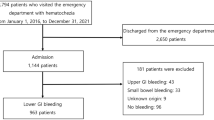Abstract
Background
The impact of comorbidities on outcomes of patients with lower gastrointestinal bleeding (LGIB) remains unknown.
Objective
Investigate the prevalence of comorbidities and impact on outcomes of patients with LGIB.
Methods
The Nationwide Inpatient Sample 2010 was used to identify patients who had a primary discharge diagnosis of LGIB based on International Classification of Diseases, the 9th revision, clinical modification codes. The presence of comorbid illness was assessed using the Elixhauser index. Logistic regression models were used to assess the contributions of the individual Elixhauser comorbidities to predict in-hospital mortality.
Results
A total of 58,296 discharges with LGIB were identified. The overall mortality was 2.3 %. Among the patients who underwent colonoscopy, 17.3 % of patients had therapeutic intervention. As the number of comorbidities increased (i.e., 0, 1, 2, or >3), mortality increased (1.7, 2.0, 2.4, and 2.4 %, respectively). The mortality rate was highest in patients >65 years of age (2.7 %). Patients >65 years of age with two or more comorbidities had a mortality rate of 5 % as compared to 2.6 % in those with less than two comorbidities. Congestive heart failure (odds ratio, 1.67 [95 % confidence interval, 1.48–1.95]), liver disease (2.64 [1.83–3.80]), renal failure (1.99 [1.70–2.33]), and weight loss (2.66 [2.27–3.12]) were associated with a significant increase in mortality rate. Comorbidities increased hospital stay and costs.
Conclusions
Comorbidities were associated with increased the risk of mortality and health care utilization in patients with LGIB. Identification of comorbidities and development of risk-adjustment tools may improve the outcome of patients with LGIB.

Similar content being viewed by others
References
Lanas A, Garcia-Rodriguez LA, Polo-Tomas M et al (2009) Time trends and impact of upper and lower gastrointestinal bleeding and perforation in clinical practice. Am J Gastroenterol 104:1633–1641
Leontiadis GI, Molloy-Bland M, Moayyedi P, Howden CW (2013) Effect of comorbidity on mortality in patients with peptic ulcer bleeding: systematic review and meta-analysis. Am J Gastroenterol 108(3):331–345
Parasa S, Navaneethan U, Sridhar AR, Venkatesh PG, Olden K (2013) End-stage renal disease is associated with worse outcomes in hospitalized patients with peptic ulcer bleeding. Gastrointest Endosc 77(4):609–616
Venkatesh PG, Parasa S, Njei B, Sanaka M, Navaneethan U (2013) Increased mortality with peptic ulcer bleeding in patients with both compensated and decompensated cirrhosis. Gastrointest Endosc. doi:10.1016/j.gie.2013.08.026
Strate LL, Ayanian JZ, Kotler G, Syngal S (2008) Risk factors for mortality in lower intestinal bleeding. Clin Gastroenterol Hepatol 6(9):1004–1010
Navaneethan U, Njei B, Venkatesh PG, Sanaka MR (2014) Timing of colonoscopy and outcomes in patients with lower GI bleeding: a nationwide population-based study. Gastrointest Endosc 79(2):297–306
Elixhauser A, Steiner C, Harris DR, Coffey RM (1998) Comorbidity measures for use with administrative data. Med Care 36(1):8–27
Deyo RA, Cherkin DC, Ciol MA (1992) Adapting a clinical comorbidity index for use with ICD-9-CM administrative databases. J Clin Epidemiol 45(6):613–619
Southern DA, Quan H, Ghali WA (2004) Comparison of the Elixhauser and Charlson/Deyo methods of comorbidity measurement in administrative data. Med Care 42:355–360
Cost-to-Charge Ratio Files. Healthcare Cost and Use Project (HCUP). September 2012. Agency for Healthcare Research and Quality, Rockville, MD. www.hcup-us.ahrq.gov/db/state/costtocharge.jsp
Rockall TA, Logan RF, Devlin HB et al (1996) Risk assessment after acute upper gastrointestinal hemorrhage. Gut 38:316–321
Kang JY, Elders A, Majeed A et al (2006) Recent trends in hospital admissions and mortality rates for peptic ulcer in Scotland 1982–2002. Aliment Pharmacol Ther 24:65–79
Caldwell SH, Hoffman M, Lisman T, Macik BG, Northup PG, Reddy KR et al (2006) Coagulation disorders and hemostasis in liver disease: pathophysiology and critical assessment of current management. Hepatology 44:1039–1046
Tripodi A, Mannucci PM (2011) The coagulopathy of chronic liver disease. N Engl J Med 365:147–156
Hughes JS, Iezzoni LI, Daley J, Greenberg L (1996) How severity measures rate hospitalized patients. J Gen Intern Med 11(5):303–311
Jencks SF, Williams DK, Kay TL (1988) Assessing hospital-associated deaths from discharge data: the role of length of stay and comorbidities. JAMA 260(15):2240–2246
Agency for Healthcare Research and Quality. Healthcare Cost and Utilization Project (HCUP) database. May 2011. Agency for Healthcare Research and Quality Web site. http://www.hcup-us.ahrq.gov/nisoverview.jsp. Accessed 31 May 2011
Lanas A, García-Rodríguez LA, Polo-Tomás M et al (2011) The changing face of hospitalization due to gastrointestinal bleeding and perforation. Aliment Pharmacol Ther 33(5):585–591
Grant support
The study is supported by a research grant from the American College of Gastroenterology (to U.N).
Conflict of interest
The authors declared no financial conflict of interest.
Author information
Authors and Affiliations
Corresponding author
Additional information
Basile Njei and Preethi GK Venkatesh contributed equally to the paper.
Electronic supplementary material
Below is the link to the electronic supplementary material.
ESM 1
(DOC 26 kb)
Rights and permissions
About this article
Cite this article
Venkatesh, P.G.K., Njei, B., Sanaka, M.R. et al. Risk of comorbidities and outcomes in patients with lower gastrointestinal bleeding-a nationwide study. Int J Colorectal Dis 29, 953–960 (2014). https://doi.org/10.1007/s00384-014-1915-x
Accepted:
Published:
Issue Date:
DOI: https://doi.org/10.1007/s00384-014-1915-x



